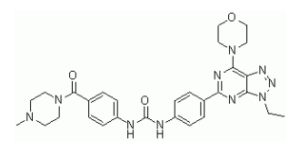PKI-402
This product is for research use only, not for human use. We do not sell to patients.

For small sizes, please check our retail website as below: www.invivochem.com
| Size | Price | Stock |
|---|---|---|
| 250mg | $1340 | Check With Us |
| 500mg | $1950 | Check With Us |
| 1g | $2925 | Check With Us |
Cat #: V0141 CAS #: 1173204-81-3 Purity ≥ 98%
Description: PKI-402 is a novel, potent, dual and pan-inhibitor of PI3K/mTOR (phosphatidylinositol 3-kinase/mammalian target of rapamycin) with potential anticancer activity.
Top Publications Citing Invivochem Products
Publications Citing InvivoChem Products
Product Promise

- Physicochemical and Storage Information
- Protocol
- Related Biological Data
- Stock Solution Preparation
- Quality Control Documentation
| Molecular Weight (MW) | 570.65 |
|---|---|
| Molecular Formula | C29H34N10O3 |
| CAS No. | 1173204-81-3 |
| Storage | -20℃ for 3 years in powder formr |
| -80℃ for 2 years in solvent | |
| Solubility In Vitro | DMSO: 0.4 mg/mL (0.7 mM)r |
| Water:<1 mg/mLr | |
| Ethanol: <1 mg/mL | |
| Solubility In Vivo | 30% PEG400+0.5% Tween80+5% Propylene glycol: 30 mg/mL |
| SMILES Code | O=C(NC1=CC=C(C(N2CCN(C)CC2)=O)C=C1)NC3=CC=C(C4=NC(N5CCOCC5)=C(N=NN6CC)C6=N4)C=C3 |
| Synonyms | PKI402; PKI 402; PK-I402 |
| Protocol | In Vitro | PKI-402 is an equipotent inhibitor of class I PI3K, including the E545K and H1047R PI3K-α mutants (IC50=2, 3 and 3 nM for PI3Kα, PI3Kα-H1047R and PI3Kα-E545K, respectively). PKI-402 causes in vitro growth inhibition of human tumor cell lines derived from a diverse set of human tumor tissues, including breast, brain (glioma), pancreas, and non-small cell lung cancer (NSCLC) tissues. PKI-402 inhibits MDA-MB-361 [breast: Her2+ and PIK3CA mutant (E545K)], with an IC50 of 6 nM. PKI-402 inhibits HCT116 (K-Ras and PIK3CA mutant) with an IC50 of 33 nM. |
|---|---|---|
| In Vivo | PKI-402 displays antitumor activity (i.v. route) in breast [MDA-MB-361: Her2+ and PIK3CA (E545K)], glioma (U87MG and PTEN), and NSCLC (A549; K-Ras and STK11) xenograft models. PKI-402 causes regression in the MDA-MB-361 xenograft model. PKI-402 effect is most pronounced at 100 mg/kg (daily for 5 days, one round), which reduces initial tumor volume and prevents tumor re-growth for 70 days. In MDA-MB-361 tumor tissue, PKI-402 at 100 mg/kg (single dose) fully suppresses p-Akt at both the T308 and the S473 sites at 8 hours and induces cleaved PARP. At 24 hours, p-Akt suppression is still evident, as is cleaved PARP. |
These protocols are for reference only. InvivoChem does not
independently validate these methods.
| Solvent volume to be added | Mass (the weight of a compound) | |||
|---|---|---|---|---|
| Mother liquor concentration | 1mg | 5mg | 10mg | 20mg |
| 1mM | 1.7524 mL | 8.7619 mL | 17.5239 mL | 35.0478 mL |
| 5mM | 0.3505 mL | 1.7524 mL | 3.5048 mL | 7.0096 mL |
| 10mM | 0.1752 mL | 0.8762 mL | 1.7524 mL | 3.5048 mL |
| 20mM | 0.0876 mL | 0.4381 mL | 0.8762 mL | 1.7524 mL |
The molarity calculator equation
Mass(g) = Concentration(mol/L) × Volume(L) × Molecular Weight(g/mol)
Mass
=
Concentration
×
Volume
×
Molecular Weight*
The dilution calculator equation
Concentration(start)
×
Volume(start)
=
Concentration(final)
×
Volume(final)
This equation is commonly abbreviated as: C1 V1 = C2 V2
Concentration(start)
C1
×
Volume(start)
V1
=
Concentration(final)
C2
×
Volume(final)
V2
Step One: Enter information below
Dosage mg/kg
Average weight of animals g
Dosing volume per animal µL
Number of animals
Step Two: Enter the in vivo formulation
%DMSO
+
%
+
%Tween 80
+
%ddH2O
Calculation Results:
Working concentration:
mg/ml;
Method for preparing DMSO master liquid:
mg
drug pre-dissolved in
µL
DMSO(Master liquid concentration
mg/mL)
,Please contact us first if the concentration exceeds the DMSO solubility of the batch of drug.
Method for preparing in vivo formulation:
Take
µL
DMSO master liquid, next add
µL
PEG300, mix and clarify, next add
µL
Tween 80,mix and clarify, next add
µL
ddH2O,mix and clarify.
Note:
- (1) Please be sure that the solution is clear before the addition of next solvent. Dissolution methods like vortex, ultrasound or warming and heat may be used to aid dissolving.
- (2) Be sure to add the solvent(s) in order.




































